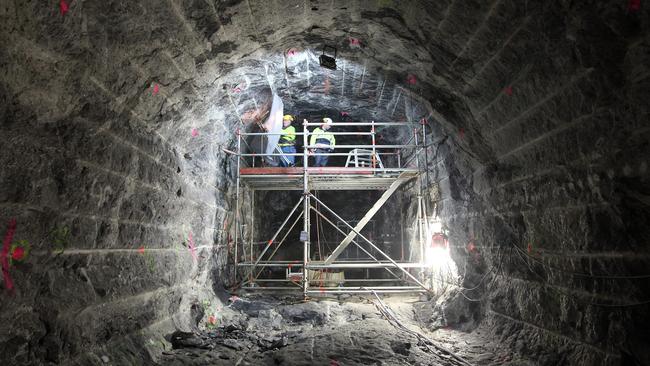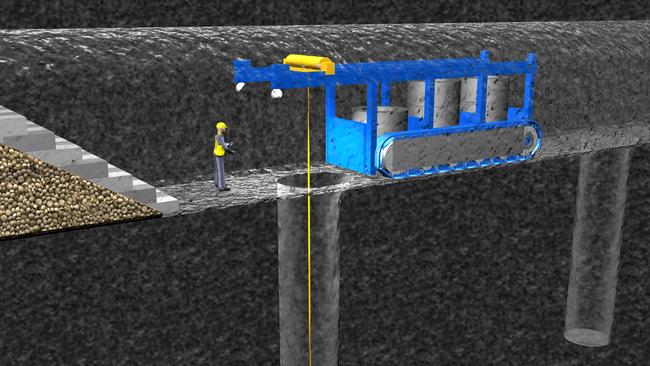National low-level nuclear waste dump likely to be in South Australia
SOUTH Australia is highly likely to house a national low-level nuclear waste dump because two sites are expected to be on a final shortlist to be revealed within weeks.

SA News
Don't miss out on the headlines from SA News. Followed categories will be added to My News.
- Three SA sites on national shortlist for nuclear dump
- Push for high-level nuclear waste storage at old atom bomb test site
- Major centres wary of waste dump
- Opinion: The one big thing the Nuclear Royal Commission missed
SOUTH Australia is highly likely to house a national low-level nuclear waste dump with two SA sites expected to be on a final shortlist to be revealed within weeks.
Three of six sites pinpointed for the national repository last November are in SA and it is expected two of these will be chosen when this list is further narrowed down after mid-March.
One of two proposed sites near Kimba is expected to make the final shortlist — it is not known which one — as is another north of Port Augusta.
Federal Resources and Energy Minister Josh Frydenberg, who is spearheading the long-running search for a national low-level dump, has committed to narrowing down the six short-listed sites to two or three after public consultation ends on March 11.
This means Mr Frydenberg likely will be choosing the final site from two in SA, making the state certain to house the dump, or two in SA and one interstate.
The owners of all of the six short-listed sites — the others are in NSW, Queensland and the NT — were among 28 that volunteered to host the so-called National Radioactive Waste Management Facility.


This would house low-level waste produced in Australia, such as surgical gloves and test tubes from hospitals and laboratories, along with intermediate-level waste generated by reprocessing fuel rods from the research reactor at Sydney’s Lucas Heights in a separate building.
The national low-level dump is being proposed by the Federal Government in a separate process from the State Government’s Nuclear Fuel Cycle Royal Commission, whose interim findings on Monday proposed a high-level waste repository for overseas spent nuclear fuel be built in SA.
Government officials and industry experts on Wednesday converged on Kimba, 460km northwest of Adelaide, to brief the population of less than 1500 about the process to decide the site for the low-level repository.
The Industry, Innovation and Science Department’s Bruce Wilson told a briefing there was no guarantee any of the sites, including one north of Hawker, would ultimately house the repository.
“Nothing will be built without broad community support and no one group will have a veto,” said Mr Wilson, one of seven bureaucrats and industry advisers flown to SA for the meeting.
“And this stage we don’t know if any site is suitable.”

It is estimated the 40ha repository, based on one at El Cabril in Spain, will take two years to complete and become operational.
Mr Wilson said the plant would be used for 100 years and would need to be monitored for a further 200 years.
Mr Frydenberg has vowed to choose the final low-level repository site by the end of the year.
The Greens are vowing to fight the planned low-level dump, saying the storage of spent fuel rods from Lucas Heights, in particular, posses a frightening health risk.
In 2004, the-then prime minister John Howard abandoned plans for a national low-level dump at a sheep station near Woomera following a highly successful legal and political campaign spearheaded by the then-premier Mike Rann.
What makes a nuclear waste dump?
Port
Waste would come from overseas in transport canisters by sea, arriving at an SA port. It is proposed a new purpose-specific port be developed rather than an existing one be used. The new port would need to be able to service boats of up to 120m, with cranes able to lift 140 tonnes. About 10 hectares of wharf space is required to allow the unloading and movement of casks. Estimated to cost about $100 million dollars, based on existing examples.

Rail
A secure line would be needed to take the waste casks from the port to an interim above-ground waste storage facility. For safety reasons, rail is preferred to road. Without a site having been selected, the length and cost of the rail is unclear. However, a site less than 5km from the port is preferred.
Road
Vehicles must still be able to travel directly from the port to the storage facilities by road. It is expected the roads would follow alongside the rail corridor and between sites, with cost unclear.
Airport
Speedy delivery of workers and supplies would be needed by air, especially if a remote interim storage facility is selected. An airport about the size of that in Roxby Downs, with a 2km runway able to accept F100 planes is anticipated. Construction cost of about $7 million.

Interim storage facility
A complex development that needs power and water, as well as hi-tech equipment for storing hazardous waste above ground in silo-like casks, that rest on concrete pads. It would need internal roads, car parking, fencing and a $17 million security system as well as buildings with administrative, technical and storage spaces. Opens 11 years after a decision to go ahead is taken. Waste moves to permanent storage 17 years later. Costs about $2.2 billion to build.
Permanent storage facility
A secure, underground repository comprising a series of tunnels into which specially designed canisters containing used fuel and intermediate level waste are deposited for permanent
disposal. Small footprint on the surface, but drills down 500m into the secure bedrock. The most comparable facility in the world is in Finland, where the country intends to store its own waste, eventually sealing off the facility permanently when no longer needed to prevent any access. SA facility costs about $38 billion to build, constructed over 100 years before it is decommissioned.


